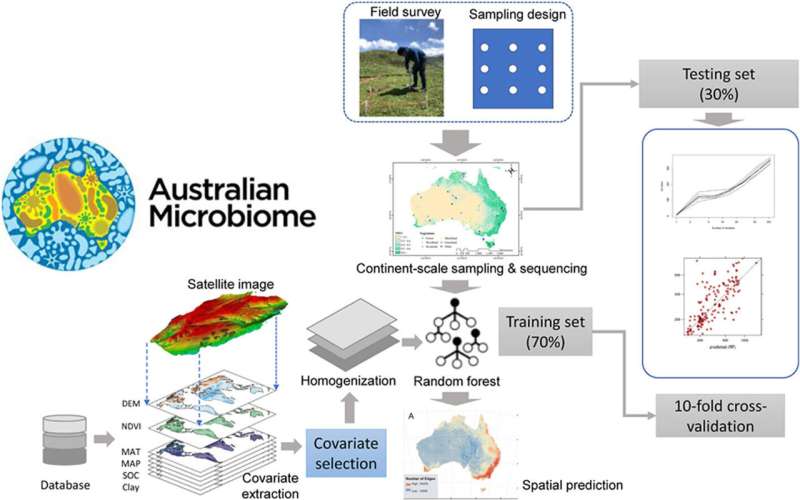This article has been reviewed according to Science X's editorial process and policies. Editors have highlighted the following attributes while ensuring the content's credibility:
fact-checked
trusted source
proofread
Scientists take a close look at Australia's soil profiles

Even the most degraded and poor quality soil can be enhanced by improving its smallest components—its fungi, archaea and bacteria microorganisms.
To decipher the complex network of soil microbial profiles across Australia, scientists from Chinese Academy of Sciences (CAS), Xi'an Jiaotong-Liverpool University and Flinders University in South Australia examined the biodiversity of savanna ecosystems from 166 research sites and seven geographically distinct vegetation types from the Australian Microbiome Initiative.
The study is published in Soil Biology and Biochemistry.
"Soil microbial profiles contribute most of the biodiversity of ecosystems, not least plant health and growth," says Associate Professor Heng Gui, from the Kunming Institute of Botany, Chinese Academy of Sciences.
"This research indicates that soils in the Australian savannah systems harbor a unique microbial association pattern, with the highest proportion of positive linkages, highest modularity and lowest average path length in comparison to soils from other vegetation types.
"Multi-model approaches reveal that the different environmental drivers, including soil properties, temperature and vegetation type, appear to regulate the spatial distribution of topological parameters of the soil microbial networks analyzed in our study."
For example, the dominant bacteria in Australian soil is the drought-tolerant actinobacteria—also uncovered by researchers mining the Bioplatforms Australia soil database. Once a soil's microbiome becomes unbalanced, it can be very difficult to restore.
Co-author Flinders University Associate Professor Martin Breed says that local and continental scale studies of microbial characteristics help to explain how environmental factors contribute to the symbiotic and indirect relationships between soil microorganisms—and how to maintain or restore soil quality.
"Our latest study suggests that ecosystem recovery must rapidly improve in order to keep up with the scale and pace of ecosystem degradation," says Associate Professor Breed, who researches ecosystem health, restoration ecology and genomics, and the associated effects on human health with fellow Flinders University researchers.
"Microbiomics and other studies are working on creative ways for restoration scientists to tackle the complexities of ecosystem degradation."
Another co-author on the Soil Biology and Biochemistry report, Associate Professor Peter Mortimer, from the Kunming Institute of Botany Department of Economic Plants and Biotechnology, says the distribution of forests and other vegetation across countries is intrinsically tied to soil profiles.
"Much more needs to be done on soil microbial geography research on a large scale to understand how environmental factors, including hotter, dryer weather, can affect plants and other conditions."
More information: Heng Gui et al, Continental-scale insights into the soil microbial co-occurrence networks of Australia and their environmental drivers, Soil Biology and Biochemistry (2023). DOI: 10.1016/j.soilbio.2023.109177
Provided by Flinders University



















